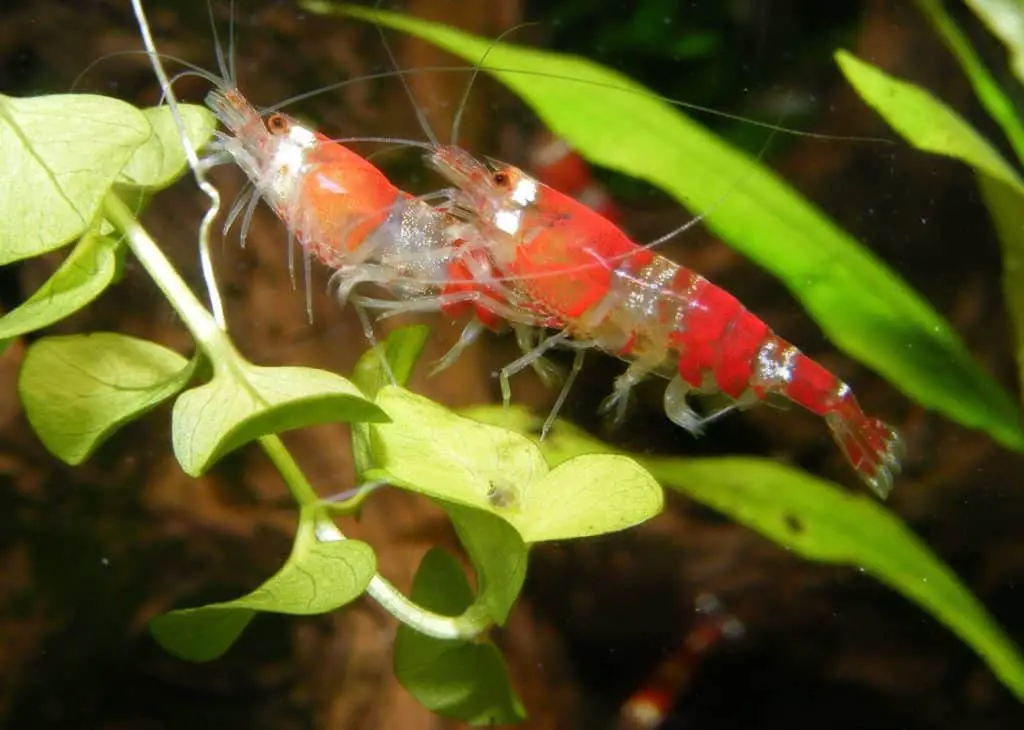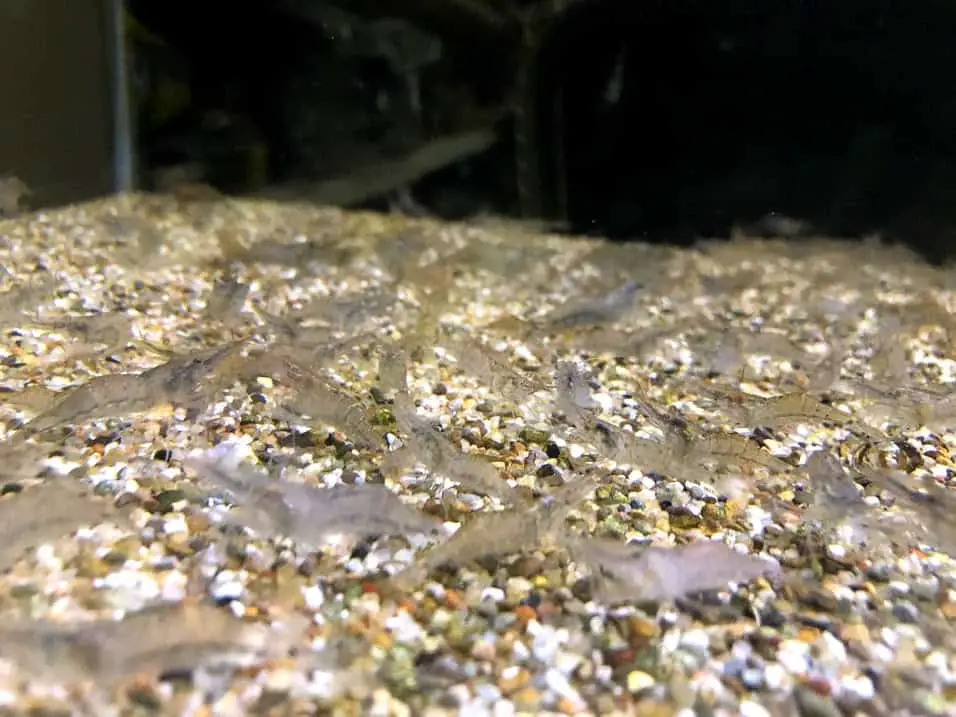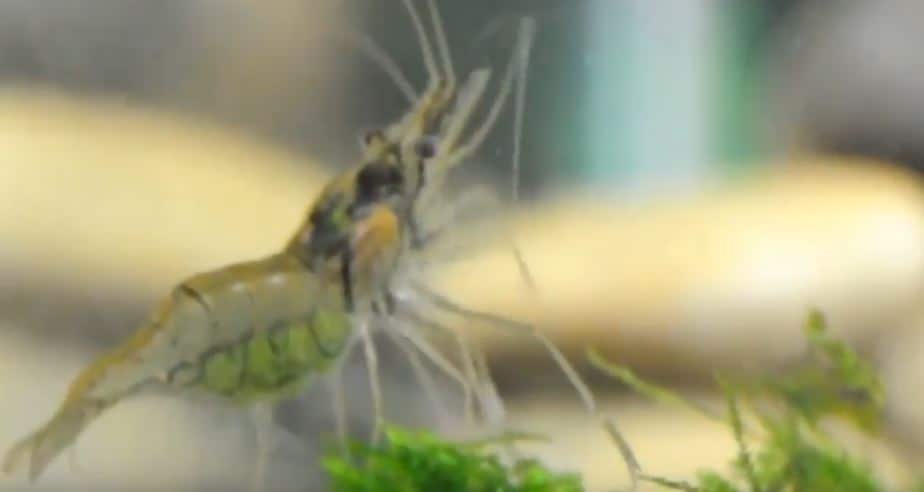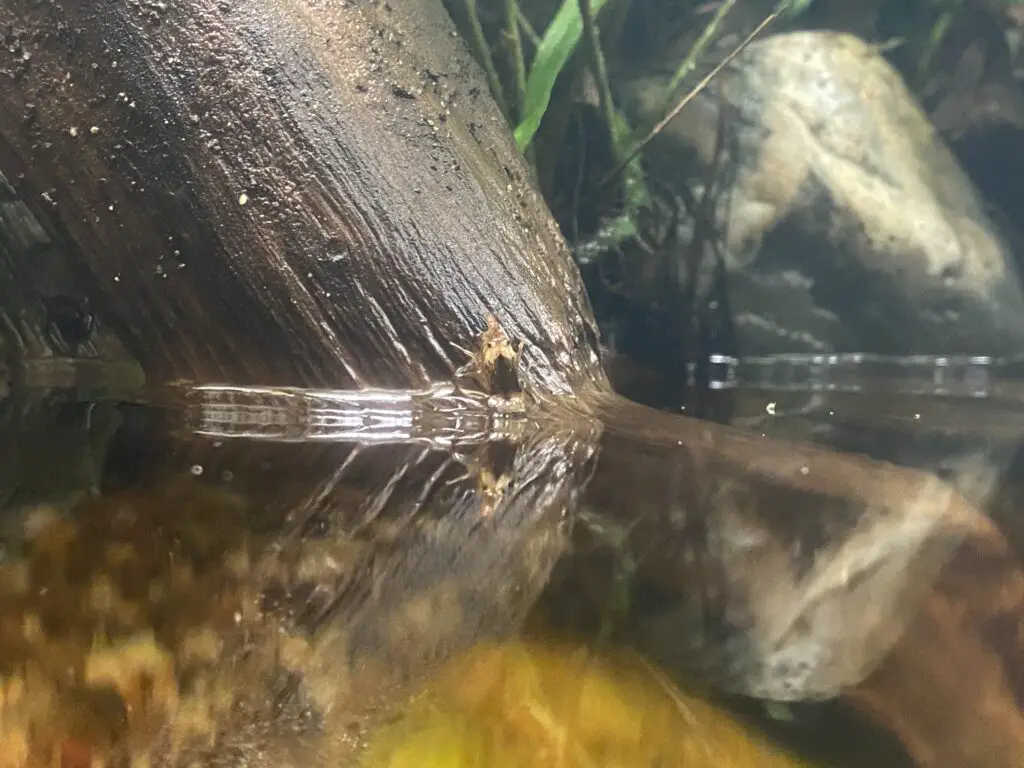Molting is a natural process that occurs in all crustaceans, but various problems can accompany it. In this article, we’ll discuss the basics of shrimp molting and some common issues that come with it.
Knowing what to expect when your aquarium shrimp starts molting can help you manage any issues before they become unmanageable.
Molting is when animals shed their exoskeleton and replace it with a new one. This is an important part of the animal’s growth and development, but if not done properly, it can lead to serious health problems for your shrimp. Read on to learn more about ensuring your aquatic pet stays healthy throughout molting.
What Is Shrimp Molting
Shrimp molting is a process that is as mysterious as the deep blue sea. It’s an essential part of their lifecycle, and understanding it can help you ensure your shrimp remain healthy.
Molting is the process of shedding a shrimp’s exoskeleton. They grow and develop like other animals with an exoskeleton, such as crabs or lobsters.
The molt cycle happens several times during a shrimp’s life when it sheds its old shell and forms a new one that fits its larger size. During this cycle, they are often vulnerable to predators since their new shell isn’t hard enough yet. They also need extra food during molting, which requires more energy and nutrients than normal. This is why having the right environment with plenty of nutritious food and hiding places is important when caring for shrimp.
With the right conditions, shrimp can molt without issue successfully, but if something goes wrong, it can be disastrous for your tank inhabitants.
What To Expect During Molting
Paying close attention to your shrimp during the molting process is important. While it can be both exciting and nerve-wracking, it’s essential for the health and well-being of your tank inhabitants. Here are some things to keep in mind:
- Shedding: During molting, the old exoskeleton will shed off in pieces or all at once. This is a normal part of molting and should not cause alarm.
- Molting Cycle: The frequency and duration of each molt cycle can vary between species. Most species have an average molt pattern of 4-6 weeks, but this can range from 2-8 weeks depending on their environment and diet.
- Exoskeleton Development: After a successful molt, you should see that their new exoskeleton has grown larger than their old one. This is a sign that they’ve completed the molting process successfully, so ensure they have enough space to move around as they grow.
- Nutrition Levels: A shrimp’s food intake needs to increase during molting due to the extra energy needed for growth. Ensure that your tank has plenty of nutritious options available for them during this time, such as algae wafers or frozen foods like brine shrimp or mysis shrimp.
These simple steps will help your shrimp get through their molting cycle with ease, allowing them to enjoy a long healthy life in your aquarium!

Signs Of Healthy Molting
Now that you understand what to expect during the molting process, it’s important to know the signs that indicate healthy molting. A successful molt will look and feel different than a failed one, so it’s important to be able to spot the differences. Here are a few things to keep an eye out for:
- Normal Molting Process: The process should take 4-6 weeks on average, but this can vary depending on the shrimp species. If they take longer than expected, it could indicate an unhealthy molt.
- Normal Molting Rate: Healthy molts should occur in moderate numbers, with 2-4 molts per year being normal for most species. If your shrimp are molting too often or not enough, this could indicate an unhealthy molt.
- Clear Exoskeleton: After each molt, their new exoskeleton should be clear and free from discoloration or markings. This is a sign that the previous shell has been shed successfully and the new shell has hardened correctly after growth.
- Completed Molting Cycle: A completed cycle should result in their exoskeleton being larger than the old one – indicating successful growth during the molt. If they remain the same size or smaller after each molt, this could indicate health and diet problems.
Paying close attention to these signs of healthy molting ensures your shrimp will stay happy and healthy in your aquarium!
Causes Of Abnormal Molting
Unfortunately, amidst the normal molting process, there are times when your shrimp may experience abnormal molting. It’s estimated that over 30% of all aquarium shrimp will encounter an unhealthy molt at least once during their lifetime. When this happens, it’s important to understand why and how to fix the issue as soon as possible. Here are some of the most common causes of abnormal molting:
• Water Quality Issues: Poor water quality can be a major factor in abnormal molting. If your tank is poorly maintained or lacks essential minerals and nutrients, it can cause your shrimp to experience shell development and growth issues.
- Insufficient Nutrition: Shrimp require a balanced diet to maintain health and prevent abnormal molting. If they are not receiving enough food or the right food, they will not have the energy needed for successful molts.
- Physical Damage: In some cases, physical damage to their exoskeleton can lead to unsuccessful molting attempts. This could include any abrasions or scratches caused by other animals in the tank or rough substrate material like sand or gravel.
- Stressful Environment: Stressful environments can cause shrimp to experience an unhealthy molt. This includes any tank parameters outside what is considered safe for their species, such as too much heat or light, lack of oxygen, etc.
These four factors are all important considerations for preventing abnormal molting in your aquarium shrimp. By addressing any potential issues before they become a problem, you can ensure your shrimp remain healthy and happy!

Poor Water Quality
Water quality is one of the most important factors in preventing abnormal molting in your aquarium shrimp. Poor water quality can cause various issues, from shell abnormalities to stunted growth. You must maintain good water quality conditions to ensure your shrimp stay healthy and have successful molts.
The first step in maintaining good shrimp water quality is monitoring your tank’s parameters regularly. This includes measuring pH, ammonia, nitrite, and nitrate levels with a water test kit. By keeping an eye on these values and keeping them within safe ranges for your species, you can prevent any sudden changes which could lead to unhealthy molting attempts.
In addition to monitoring the water parameters, it’s also important to do regular maintenance on your tank. This includes cleaning the filter regularly, removing excess food and waste from the substrate, and doing partial water changes every week or two. All of these tasks will help keep your tank free from pollution and debris that could affect the health of your shrimp.
By taking these steps to maintain good water quality conditions in your aquarium, you can give your shrimp the best chance of having successful molts without any issues.
Insufficient Nutrition
Molting problems can also be caused by insufficient nutrition. Malnutrition is a serious issue for aquarium shrimp, as the lack of proper nutrients can lead to abnormal molting and other health issues. You must provide a nutrient-rich diet to keep your shrimp healthy and happy.
There are several signs to watch out for when determining if your shrimp suffer from malnutrition. These include thin shells, stunted growth, and discoloration of the exoskeleton. If you notice any of these symptoms in your shrimp, it could indicate that they aren’t receiving the proper nutrition.
To prevent malnutrition in your tank, it’s important to understand the nutritional requirements of your species. Shrimp have different dietary needs, so research what food they need to stay healthy and strong. It’s also important to provide a variety of food sources such as algae wafers, blanched vegetables, frozen foods, and live foods like brine shrimp or blackworms. By providing a wide range of food options, you can ensure that your shrimp receive all the nutrients they need for a successful molt.
If malnutrition is left unchecked in an aquarium, it can have serious consequences for your shrimp. Malnourished specimens may suffer from shell deformities or become more susceptible to diseases due to weakened immune systems. To keep your aquarium inhabitants healthy and happy, you must always maintain proper nutrition levels.
Stressful Environment
Stressful environments can also lead to problems with molting in aquarium shrimp. Environmental stressors, such as sudden changes in temperature, water chemistry, and light levels, can create stressful conditions that disrupt the molt cycle. Additionally, overcrowding and poor water quality can be environmental triggers for molting issues. Even small unfavorable conditions can lead to abnormal molting or other health problems.
To prevent environmental stress from affecting your shrimp’s molt cycle, it’s important to maintain a stable environment in the tank at all times. Ensure you don’t change the tank’s parameters and keep the water clean and pollutant-free. Additionally, try not to overcrowd the tank and provide plenty of places for your shrimp to hide if they feel stressed.
Here are four simple steps you can take to create a healthy environment for your shrimp:
- Monitor your tank’s water temperature closely and ensure it stays within an acceptable range for your species.
- Use a reliable testing kit to keep the pH level consistent and adjust according to specific guidelines.
- Provide plenty of hiding spaces for your shrimp, so they have a place to retreat when feeling stressed.
- Avoid overfeeding and perform regular water changes to ensure that ammonia levels remain low in the tank.
By creating an optimal environment for your aquarium inhabitants, you can help reduce environmental stressors that could interfere with their molt cycles.

Physical Damage
Shrimp can also experience molting issues due to physical damage. While they are known for their hard shells, aquarium shrimp are still vulnerable to accidental damage caused by predators or sharp objects in the tank. The most common type of physical damage is shell damage, which can cause your shrimp to shed their exoskeleton prematurely. Sometimes, the shell may be visibly cracked or chipped, but it can also occur without visible injury.
In addition to shell damage, shrimp can suffer from internal injuries caused by scrapes and cuts. These injuries can cause your shrimp to molt prematurely, leaving the animal vulnerable to infection and other health complications. Finally, it’s important to note that shrimp may also experience molting issues due to an underlying disease or parasite infestation.
A good way to reduce the risk of physical damage and other health problems is to ensure you provide a safe environment for your shrimp. This means avoiding overcrowding in the tank and using smooth decor that won’t injure your animals. Additionally, it’s important to monitor the water quality closely and regularly check for signs of disease or parasites to prevent any potential health issues from affecting your shrimp’s molt cycle.
With these precautions in place, you can help ensure that your aquarium inhabitants remain healthy and free from molting problems caused by physical damage.
Disease & Parasites
In addition to physical damage, diseases and parasites can cause molting issues in aquarium shrimp. These types of shrimp diseases and parasites can affect the molt cycle, leading to premature molting or even a complete halt in molting. Common signs of a parasitic infestation include white spots on the body, discoloration of the shell, and lethargic behavior.
If you suspect your shrimp has been infected with a parasite or disease, it’s important to take steps to treat it as soon as possible. This may involve removing infected shrimp from the tank, treating them with medicated food or medications, or performing regular water changes. It’s also important to maintain good water quality and perform regular tank maintenance to prevent disease and parasitic infestations from occurring in the first place.
Finally, it’s important to note that some shrimp species are more prone to certain diseases or parasites than others. When selecting aquarium inhabitants for your tank, be sure to research their species-specific needs so that you can provide them with an environment that supports optimum health and prevents molting disorders due to disease and parasites. With these precautions, you can help ensure your aquarium is free from any health issues affecting your shrimp’s molt cycle.
Next section H2:’Endocrine Disorders’
Endocrine Disorders
Endocrine disorders are a major cause of molting issues in aquarium shrimp. These disorders occur when hormones become imbalanced due to endocrine disruption, resulting in the improper production of molting hormones and ultimately causing molting problems. The effects of endocrine disruption can be wide-ranging, from subtle changes in behavior to more severe physical symptoms such as premature molting or an inability to molt at all.
Fortunately, there are a few steps you can take to help prevent and address endocrine disruption in your aquarium. To start, it’s important to understand the potential causes of endocrine disruption to reduce the likelihood of it occurring in your tank. This includes avoiding certain medications and chemicals, controlling water temperature and quality, and avoiding overcrowding. Additionally, providing your shrimp with foods high in calcium and other minerals can help ensure proper hormone balance.
Finally, it’s important to recognize the symptoms associated with endocrine disruption so that you can identify any potential issues sooner rather than later. Some common signs include lethargy, decreased appetite, color changes on the shell or body, and abnormal behavior. If left untreated, these issues can worsen over time, putting undue stress on your shrimp’s health.
By recognizing these signs early on, you can take steps to address any underlying problems before they lead to serious health concerns like molting issues due to endocrine disorders. With this knowledge, we can now understand and identify problems with molting in aquarium shrimp.
Identifying Problems With Molting
Identifying problems with molting in aquarium shrimp is essential for the health of your tank. While the most common cause of molting issues is endocrine disruption, other factors can lead to abnormal molting. These include water quality issues, poor nutrition, and a stressful environment. It’s important to be aware of these potential causes so you can take steps to reduce their impact on your shrimp’s health.
When it comes to spotting signs of molting abnormalities, there are several telltale indicators that you should look out for. If your shrimp appears lethargic or has a decrease in appetite, this could be an indication that something is amiss. Additionally, color changes on the shell or body can be a clue that something isn’t right. Finally, if your shrimp begins exhibiting abnormal behavior, like swimming upside down or struggling to shed its exoskeleton, this may indicate a problem with its molting process.
By being mindful of these signs and familiarizing yourself with the potential causes of molting problems, you’ll be better equipped to diagnose any issues before they become serious. Understanding the factors that affect healthy molting cycles will help you create a safe and optimal environment for keeping your aquarium shrimp happy and healthy. Now let’s focus on treatment and prevention strategies for combating molting abnormalities in aquarium shrimp.
Treatment & Prevention
Well, brine shrimp owners, it’s time to get serious about preventing and treating molting abnormalities in our aquariums. Let’s look at some of the key steps you can take to ensure your shrimp remain healthy and happy.
First and foremost, maintaining proper water quality is essential for aquarium shrimp health. Regular water changes help keep ammonia levels low while checking pH levels ensures they stay within the optimal range. Additionally, monitoring nitrate levels ensure your tank isn’t suffering from an overabundance of waste particles that could be stressing your shrimp.
Next up on the list: nutrition! A balanced diet is key for any living creature, which applies to aquatic species. Ensure that your shrimp has all the necessary micronutrients to develop their exoskeletons effectively during molting cycles. If you’re having trouble providing them with these vitamins and minerals naturally, consider supplementing their feeding regimen.
Finally, creating a stress-free environment is crucial for healthy molting processes in aquarium shrimp. Avoid overcrowding your tank by providing adequate space for each shrimp; this will help reduce competition between them regarding food or shelter. Additionally, ensure the temperature fluctuations aren’t too extreme; sudden changes can cause issues when it comes time for shedding their exoskeleton.
By taking care of these three elements: water quality, nutrition, and the environment, you’ll be setting yourself up for success in avoiding molting problems in aquarium shrimp! Now let’s turn our attention to adjusting certain conditions in the tank itself that may negatively impact your shrimp’s health.
Adjusting The Aquarium Conditions
Having discussed the importance of proper water quality, nutrition, and environment for healthy shrimp molting, let’s now focus on adjusting certain conditions in the tank itself. By doing so, we can help create an optimal environment for our shrimp conducive to successful molting cycles.
To start, it’s important to understand the specific water parameters ideal for aquarium shrimp. While pH should be kept between 6.5 and 7.8, the temperature should remain stable within a range of 74 – 78 degrees Fahrenheit (23 – 26 degrees Celsius). Nitrates should stay below 10 ppm, and ammonia levels should always be at 0 ppm.
It’s also essential to ensure your shrimp receive the right balance of nutritional elements to maintain healthy exoskeletons during the molting process. Ensure their diet consists of various food sources, such as algae wafers, blanched vegetables, and frozen foods like brine shrimp or bloodworms, and supplement with calcium-rich foods if needed.
Finally, you’ll want to make sure your tank is designed with plenty of hiding spaces and places for your shrimp to rest and feed without feeling stressed or threatened by other inhabitants in the tank.
This will help them feel comfortable enough to complete their molting process efficiently without interruption or disruption from other species vying for space or resources in the same area. With these adjustments in place, you’ll have a much better chance of preventing issues related to aquarium shrimp molting!

Medicating The Shrimp
Coincidentally, when all else fails, and problems with shrimp molting persist, one last option can help medicate the shrimp. As daunting as this may sound, it is actually a fairly simple process and can be done easily with the right aquarium medication. While many hobbyists don’t like to use chemical treatments in their tanks, sometimes it’s necessary to prevent major issues from arising due to persistent molting problems.
Here are a few simple steps for treating your shrimp with aquarium medication:
- Research different types of medications available for shrimp-related issues.
- Choose a medication that best suits the needs of your tank.
- Follow directions on the packaging carefully and dose accordingly.
- Monitor water parameters closely during treatment and adjust as needed.
It’s important to remember that while medications can help address some molting problems, they should only be used as a last resort since they have potential side effects, such as affecting water chemistry, that could harm other inhabitants in the tank if not monitored properly. Therefore, it’s always better to try adjusting environmental conditions before turning to medication to solve molting issues.
However, if all other efforts fail and you need to medicate your shrimp, doing so correctly will help ensure successful treatment and long-term care of your aquarium inhabitants!
Long-Term Care
With the right approach, long-term care of your aquarium and its inhabitants is attainable. Proper aquarium maintenance and monitoring of water parameters are key to maintaining a healthy environment for your shrimp while adhering to their dietary requirements ensures they stay in good condition. Here are four essential components of long-term shrimp care:
- Monitor Water Parameters: Regularly check pH, nitrates, ammonia, and other important water quality levels to ensure the tank environment suits the shrimp’s health.
- Regular Tank Maintenance: Change out old water for new regularly, clean filters often, and keep an eye on algae growth.
- Dietary Requirements: Feed your shrimp a balanced diet of nutritious food specifically designed for aquatic life, such as pellet or flake foods, frozen foods, live foods, or algae wafers.
- Quarantine New Shrimp: Always quarantine new shrimp before introducing them into the main tank to protect existing inhabitants from disease or parasites that newly added specimens could bring in.
Following these steps and being proactive about monitoring your tank’s inhabitants and environmental conditions, you can ensure that your aquarium remains a safe and healthy home for all its inhabitants!
Conclusion
Molting is an important part of a shrimp’s life cycle and can be an exciting experience for the aquarium keeper. Monitoring your shrimp during molting is important to ensure that it is healthy and happy. Poor water quality, inadequate nutrition, and incorrect environmental conditions can all lead to abnormal molting, so it’s important to adjust these factors if necessary.
If you take the time to understand the signs of healthy molting and address any problems quickly, your shrimp should be able to molt successfully.
As an aquarist, I’ve seen firsthand how stressful molting can be for shrimp and owners alike! But with patience and care, you can help your shrimp have a safe and successful molt. Monitoring your tank conditions properly will ensure that your shrimp remain healthy in between molts.
Remember: if you pay attention to your aquarium environment, you’ll be able to catch potential issues before they become major problems!
Shrimp molting may seem daunting initially, but it doesn’t have to be. With the right knowledge and understanding of what goes on in the aquarium during this process, you can help ensure that each molt is stress-free for you and your shrimp!
